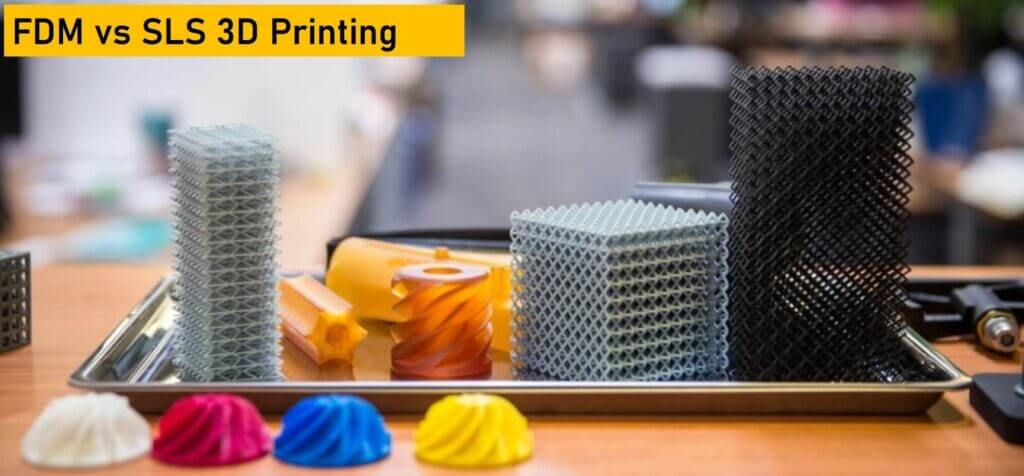3D printing technologies help enterprises become a part of Industry 4.0. In addition to driving digital transformation, 3D printing machines have been transforming production chains and supply chains. Fused Deposition Modeling (FDM) and Selective Laser Sintering (SLS) currently power a large percentage of industrial 3D printers.
FDM is the most commonly used 3D printing technology, while SLS is the second most commonly used 3D printing technology. But you should not consider market share data or installation base while choosing from FDM vs SLS 3D printing. Instead, you should focus on identifying the key differences between these widely-used additive manufacturing technologies.
FDM 3D Printing
FDM produces solid parts from digital files through the material extrusion process. The printer melts the raw material and extrudes the melted material in the form of filament from a nozzle. The nozzle deposits the filament layer by layer over a build platform or build tray till the part is created according to the digital file.
While using an FDM 3D printer, you have the option to use a wide variety of polymers. The desktop FDM 3D printers support classic materials like PLA and ABS, while the industrial-grade FDM 3D printers support high-performing materials like TPU, PET, Nylon, and PETG.
FDM is often described as a beginner-friendly and budget-friendly additive manufacturing technology. In addition to being used in various industries, FDM is hugely popular with artists, hobbyists, students, and enthusiasts. Enterprises opt for FDM to speed up manufacturing and prototyping without escalating printing costs.
SLS 3D Printing
SLS produces solid parts by sintering powdered material selectively. An SLS 3D printer sinters the material using a high-power laser. The sintering process forms the part by fusing particles. Also, the unfused powdered material provides support to the part during the printing process.
Once the part is created, engineers allow it to cool adequately inside the build chamber. They finally remove the part from the build chamber and start the post-processing activities. They use specific techniques, tools, and liquids during post-processing to improve the look, feel, and features of the finished part.
While using an SLS 3D printer, you have the option to use a variety of nylon. Polyamide 12 (PA 12) or Nylon 12 is the most commonly used material in SLS 3D printing. However, you can improve the mechanical and thermal properties of the material by opting for materials filled with additives like glass fiber, carbon fiber, and aluminum.
Major Differences: FDM vs SLS 3D Printing
Ease of Use
FDM is an easy-to-use 3D printing technology, whereas SLS is one of the complex 3D printing technologies. Enthusiasts, hobbyists, and artists can operate desktop FDM 3D printers with minimal training. But they can operate an SLS 3D printer safely only by installing the machine in a large and ventilated area. Also, they have to follow several best practices to mitigate the health and safety concerns in SLS 3D printing. That is why; most enterprises deploy trained and experienced technicians to operate SLS 3D printers.
Printing Cost
As noted earlier, FDM is a budget-friendly 3D printing technology. You have the option to choose from many desktop, benchtop, and industrial-grade FDM printers. But you have to invest more than $5000 to purchase an SLS 3D printer. Also, FDM 3D printing materials are less expensive than materials used in SLS 3D printing. Hence, enterprises and individuals opt for FDM to reduce printing costs significantly.
Printing Speed
The amount of time required by a 3D printer to produce a part depends on a variety of factors – the size of the part, choice of materials, and nozzle temperature. Also, advanced 3D printing machines produce parts faster than older models. SLS 3D printers deliver speed up to 50 millimeters per hour, while the speed delivered by FDM 3D printers range from 50 to 150 millimeter per hour. Hence, FDM is more effective in reducing printing time than SLS.
Material Options
While producing parts or prototypes using an SLS 3D printer, engineers often opt for nylon as a form of engineering thermoplastic. But you have the option to choose from several SLS 3D printing materials, including PA 11, PA 12, PA 6, and TPU. At the same time, you can choose from a wide range of filaments – PLA, ABS, TPU, PC, and TPE – while using an FDM 3D printer. The industrial-grade FDM 3D printers allow you to use specialized and blended materials. FDM allows you to choose from more materials than SLS.
Dimensional Accuracy
SLS beats FDM in the categories of dimensional accuracy and print resolution. Unlike FDM printers, SLS does not require engineers to use support materials. Hence, they find it easier to print parts with complicated geometries. Also, they experiment with fresh concepts and out-of-box ideas by enjoying design freedom. Most enterprises invest in SLS 3D printing machines and materials to produce complex parts with superior surface finish and resolution.
Part Strength
Engineers often believe that SLS is more effective than FDM in producing parts that can handle a higher level of stress or load. But several studies have highlighted that FDM beats SLS in the category of tensile strength. A part produced using FDM has 30 megapascals (MPa) tensile strength more than an identical part produced using an SLS 3D printer. Hence, engineers prefer FDM to SLS to produce stronger parts and prototypes.
Use Cases
At present, FDM and SLS 3D printing technologies are being used by enterprises in many sectors – manufacturing, automobile, automotive, aerospace, engineering, and healthcare. But engineers opt for FDM to produce parts of minimum to medium complexity. They choose SLS to produce parts with complex geometries. Many enterprises these days invest in professional SLS 3D printers to meet the requirements of complex and advanced projects.
Conclusion
FDM and SLS 3D printing technologies differ from each other in many aspects. Also, each of these additive manufacturing technologies has its pros and cons. Hence, you should compare the 3D printing technologies according to the precise needs of individual projects. Also, you can evaluate FDM vs SLS 3D printing accurately by considering important factors like timeframe, budget, and safety.

